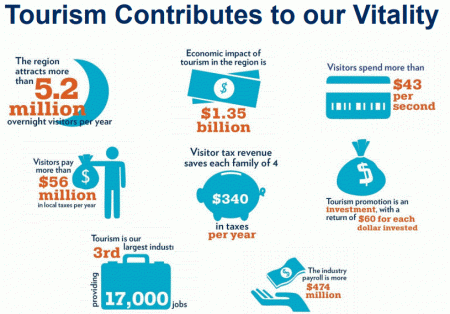
Budget Analysis
Budget Analysis provides a fact-based, compelling evaluation of current competitiveness and the economic opportunity associated with the budget funding of destination marketing
DMO budgets are benchmarked against known measurements for each destination, including:
- Hotel room revenue
- Leisure and hospitality employment
- Leisure and hospitality income
- Bed Tax Rates
Various competitive sets and indicator combinations are explored to identify those that best highlight the current situation. Based on the findings of the competitive benchmarking analysis, Tourism Economics identifies an optimal budget to enable a DMO to compete both domestically and internationally. Tourism Economics will make recommendations on funding levels based on quantitative analysis.

Economic rationale for destination marketing:
This analysis describes the competitive nature of tourism, the perishability of the product, seasonality, the value of scale, and the importance of brand development. In all these areas, a case is built for why destination promotion is an essential part of fostering the economic value of the tourism sector in the state.
This is based on a combination of economic theory, statistical analysis, and case studies. Recent Tourism Economics research on how destination marketing drives broader economic development is used as references to buttress the case for competitive funding.
When the rationale is defined, the Tourism Economics team presents both positive and negative case studies of when destination marketing has been well-funded and defunded. The iconic “Colorado story” as well as the more recent “San Diego story” authored by Adam Sacks of Tourism Economics provide cautionary tales of what happens to market share when destination marketing is defunded. More recent case studies are included.
Key performance indicators (KPIs) are also leveraged in building the case for the economic benefits of destination marketing investments.
Track competitiveness over time:
An analysis of a DMO’s tourism sector performance relative to the nation and its competitive set, which is defined in consultation with the client. Losses in market share, and the parallel effect on room nights, are calculated over the past five years.
Room demand, room revenue, leisure and hospitality employment and wages are tracked over the past ten years to determine the extent to which a destination are competing (or not) in the tourism market
Conduct scenario impact analysis:
The last phase of work produces a calculation the potential benefits of increasing the marketing budget to be in line with its competitive set.
Impacts are measured in terms of visits, business sales, jobs, income, and tax generation. Incremental visits, room nights, and spending that would be realized through investing more in destination marketing are calculated using a combination of case studies and historic KPIs.
The IMPLAN economic impact model for the region is used to calculate direct, indirect, and induced impacts by industry sector. IMPLAN is an input-output model that measures the relationships between and among industries and consumers. For example, the model tracks the flow of a visitor’s restaurant expenditures to wages, profits, capital, taxes and suppliers. The supplier chain is also traced to food wholesalers, to farmers, and so on. In this way, the model allows for the measurement of the direct and indirect sales generated by a restaurant meal, for example. The model also calculates the induced impacts of tourism. These induced impacts represent benefits to the economy as employees of tourism sectors spend their wages in the local economy, generating additional output, jobs, taxes, and wages.
Economic impacts are measured on three levels:
- Direct
- Indirect
- Induced
The results of the analysis are typically shown for two scenarios, including a “do nothing” scenario and funding scenarios over the next five years, to be defined in coordination with the client.


